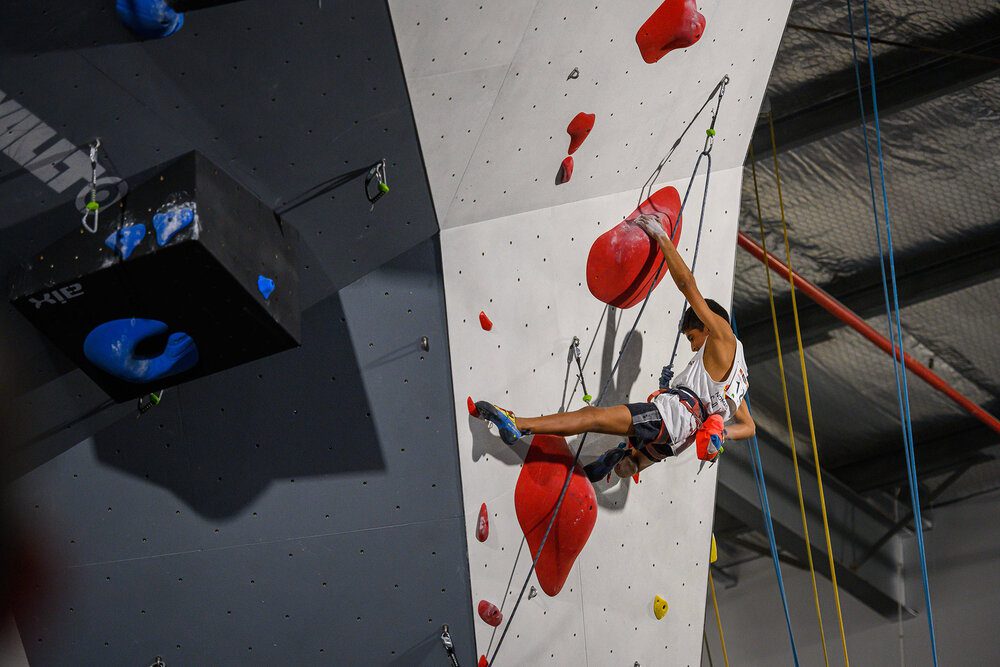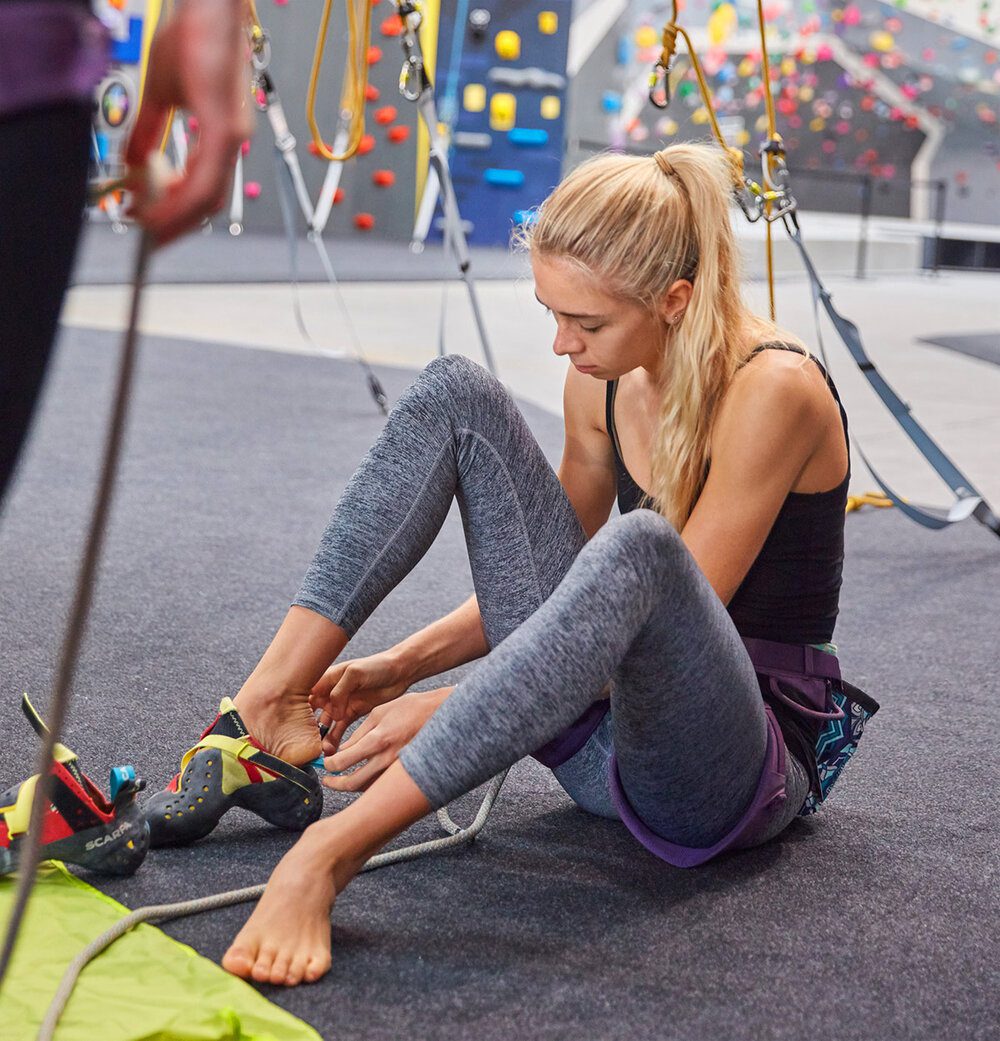
Whether you’re a first-time climber or a seasoned pro, the right climbing shoe is the most valuable piece of equipment you’ll ever possess. While several contributing factors will influence your decision, finding the choice of rubber for the sole of your climbing shoe should be the #1 item on your checklist.
The terms soft and stiff are sure to dominate your research on the matter. And if you’ve watched professional athletes competing on TV, you’ve probably noticed that they carry a pair of each. So, which is the right option for your future climbs? Let’s find out.
When describing a shoe as either ‘soft’ or ‘stiff,’ the terms actually relate to the thickness of the rubber sole and the midsole (The midsole is the layer of material that sits between the rubber sole and the leather upper). A soft shoe is one that has a much thinner rubber on the bottom of the shoe while a stiff shoe boasts a thicker shoe. While both options are built to aid your climbing activities, they achieve it in very different ways.
A softer, thinner climbing shoe is generally described as being more sensitive. This ultimately means that, due to the fact that there is less of a barrier between your foot and the hold, you will gain a far better idea of what’s beneath your foot. In turn, you can move with greater precision, which is particularly noticeable on delicate foot swaps.
Softer shoes additionally mold themselves to the shape of the foothold, which results in greater surface contact for a better sense of friction between your foot and the hold. This is particularly effective for smearing and standing on volumes. But it should be noted that, upon losing this initial friction, your feet will require more drive and power through the lift.
Conversely, though, forces move in all directions rather than the somewhat more restricted lift of stiffer shoes. In turn, this can provide greater control through the lifts. The natural sensitivity of a soft shoe additionally encourages you to develop your balance, technique and footwork.
A stiffer, thicker climbing shoe is primarily selected for its supportive nature. Rather than molding around the shape of a foothold, they create a barrier atop it. In turn, this reduces the strain on your muscles and ligaments, meaning you’ll get tired far less quickly. Beginners often find this to be a hugely beneficial factor.
The reduced strain also has rewarding results when climbing for several hours. Furthermore, the platform created on the foothold will inspire confidence when moving your body weight, which is especially noticeable when driving up for those long reaches and dynamic drives. So, when seeking better edging capabilities, this option is far better suited to your needs.
New climbers hoping to build up toe and foot muscles may want to use this first before moving onto the sensitive softer climbing shoes.
However, if you are planning to focus on vertical face climbs, you may stick with a stiffer shoe indefinitely.

Before looking at the specific attributes of any specific climbing shoe, you must also take the time to learn about how to wear climbing shoes in the correct fashion. It is imperative that the shoe is free from air bubbles and gaps, as this could seriously hinder synergy, grip, and dexterity.
Matt Adams of Expedition Equipment explains:
All shoes are built to allow climbers to perform at their highest level, regardless of their climbing abilities.
For performance, shoes must be worn tight, so all of the technical features work and this maybe is not ideal for a beginner who might find them extremely painful to wear or their toes aren’t strong enough. It does take some time (not long surprisingly) for both your foot to get used to the shape of the shoe, and your foot to build up the strength to feel that the shoe is working.
Performance shoes are all downturned in some form to mimic the natural arch shape of the foot while climbing. This shape gives the climber’s foot power to stand and move up from holds. If the shoe is loose or has a poor fit the heel will move, tension of the shoe is lost and then the ability to move up with confidence is compromised.
The process of actually putting the climbing shoes on varies from the tactic used for a normal pair of trainers. You must pull the velcro back (or loosen the laces fully) so that you can dig and twist your toes into the toe compartment of the shoe in a manner that will remove any air pockets or dead space. Following this, you’ll need to pull the heel portion over your foot and ensure that it’s tight.
When wearing shoes for the first time, it’s worth spending a minute or two walking on your toes. It can be uncomfortable but is a crucial step to ensure your foot is acclimatized to the new climbing shoe.
Recreational climbing has evolved in recent years, opening the door to new climbing styles, activities, and opportunities. In addition to considering your experience levels, it’s important to think about what you want to achieve from climbs, along with the surfaces you are most likely to ascend.
Matt Adams confirms:
Choosing the right shoe also depends on what surface and angle you are climbing on.
Slabs (off vertical walls) where friction is the key a softer shoe is better here as it molds and adapts better to the surface. If the slab has small positive footholds then a stiffer shoe will work better as a passive platform for pushing down on. Vertical or slightly overhanging the footholds are generally smaller and positive so again a stiff platform shoe will work really well.
For overhangs, you come across many different types and shapes of footholds so it’s important to select a softer shoe here that will adjust and conform to all these different footholds. Soft shoes provide the maximum feel and sensitivity for you here on steep ground and if the shoe is tensioned correctly it will allow the climber to hold good stability throughout the whole body. Softer shoes on overhangs also allow the climber’s foot to press down in multiple directions, these force vectors spread the load of pressure within the shoe and in short it means that multi muscle groups are used in the foot and less stress is applied to one particular muscle so reducing fatigue in your feet.
The choice between a hard shoe or a soft shoe, or maybe you should ask what type of climber are you?
Are you focused on precision and knowing how to place your foot correctly on small footholds to within a millimetre of perfection, an attributes developed by using rigid shoes. Or are you someone that climbs inaccurately and is not afraid of inaccuracy Moving on the climb no matter what, with fluid movement and speed are skills developed by using soft shoes.
The best approach is to work out what you want to climb and the style of your climbing, then go try on a few different styles and brands to find that perfect fit.
Even when you are equipped with the necessary information about the pros and cons of soft versus stiff shoes, navigating the climbing shoe marketplace can feel even more daunting than taking on a 5.11 wall for the first time. However, the Red Chili Climbing team is here to help.
The RED CHILI URBAN TOUR comes to Climb Fit St Leonards! Check out the event here
On the night you can Test the new MYSTIX model from the RED CHILI Collection 2020 on March 16th, 2020 at Climb Fit St Leonards, sydney from 6 pm-late.
The RED CHILI Urban Tour is a Test & Feel Tour through the hottest climbing halls in Europe. For you the relaxed opportunity to test the latest RED CHILI models directly on the climbing wall. No matter if you want to try climbing for the first time and you are still missing the right shoes or if you are already planning the hardest moves - our team of experts will be at your side with help and advice at every event.